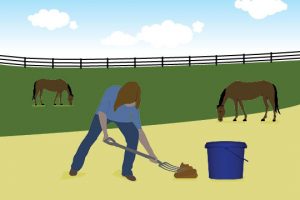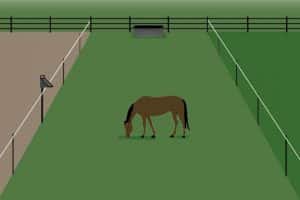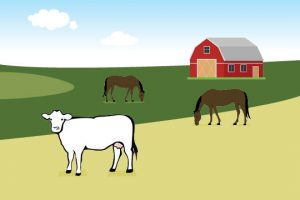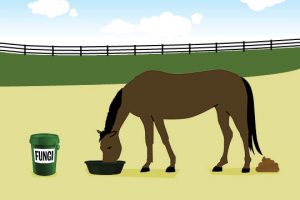Life—active and peaceful life—abounds around this herd of horses. It abounds inside the herd, too. Within each one of these shiny, healthy horses are parasites, carrying out their own unique life cycles in the equine gut. And scattered throughout this idyllic pasture are microscopic equine parasite eggs and larvae, waiting for their moment to find a host that will allow them to thrive.
Wait a minute. Can intestinal parasites really have a place in this harmonious picture? Aren’t they horrible creatures sucking the nutrients out of our beloved animals? And shouldn’t we be fighting back with deworming artillery, creating a battlefield on this otherwise serene pasture? On the contrary, as long as parasite burdens are well-managed, a coexistence between hosts (horses) and worms is quite normal—and peaceful, our sources say.
Peaceful Cohabitation
(When Controlled)

PHOTO: iStock.com
“Host-parasite relationships have been going on for several hundreds of thousands of years, with continuous adaptation on both sides,” says Dr. Hubertus Hertzberg. And there’s nothing wrong with that, says Dr. Martin Nielsen. “Parasitism is a normal state,” he says. As Hertzberg explains, these host-parasite relationships are “never-ending competitions,” but they’re certainly not battles. “It’s not like there’s a winner and a loser at the end,” he says. “It can’t be the goal of a parasite to beat its host because that would mean his end, as well.” Still, parasites can cause illness—primarily nutrient loss, diarrhea, and colic—when loads tip beyond what horses are capable of handling, our sources say. That’s why it’s up to owners and veterinary professionals to manage (rather than eradicate) parasite burdens effectively.

Hubertus Hertzberg, PhD, is a researcher at Switzerland’s University of Zurich Vetsuisse Faculty Institute of Parasitology and head of parasite monitoring at Health Balance, a private holistic animal management and veterinary practice, in nearby Niederuzwil.

Martin Nielsen, DVM, PhD, Dipl. ACVM, is associate professor and the Schlaikjer professor in equine infectious disease at the University of Kentucky’s Gluck Equine Research Center, in Lexington.
Internal Parasites: A Visual Guide

Bloodworms
Photo Credit: Dr. Lisa Edwards
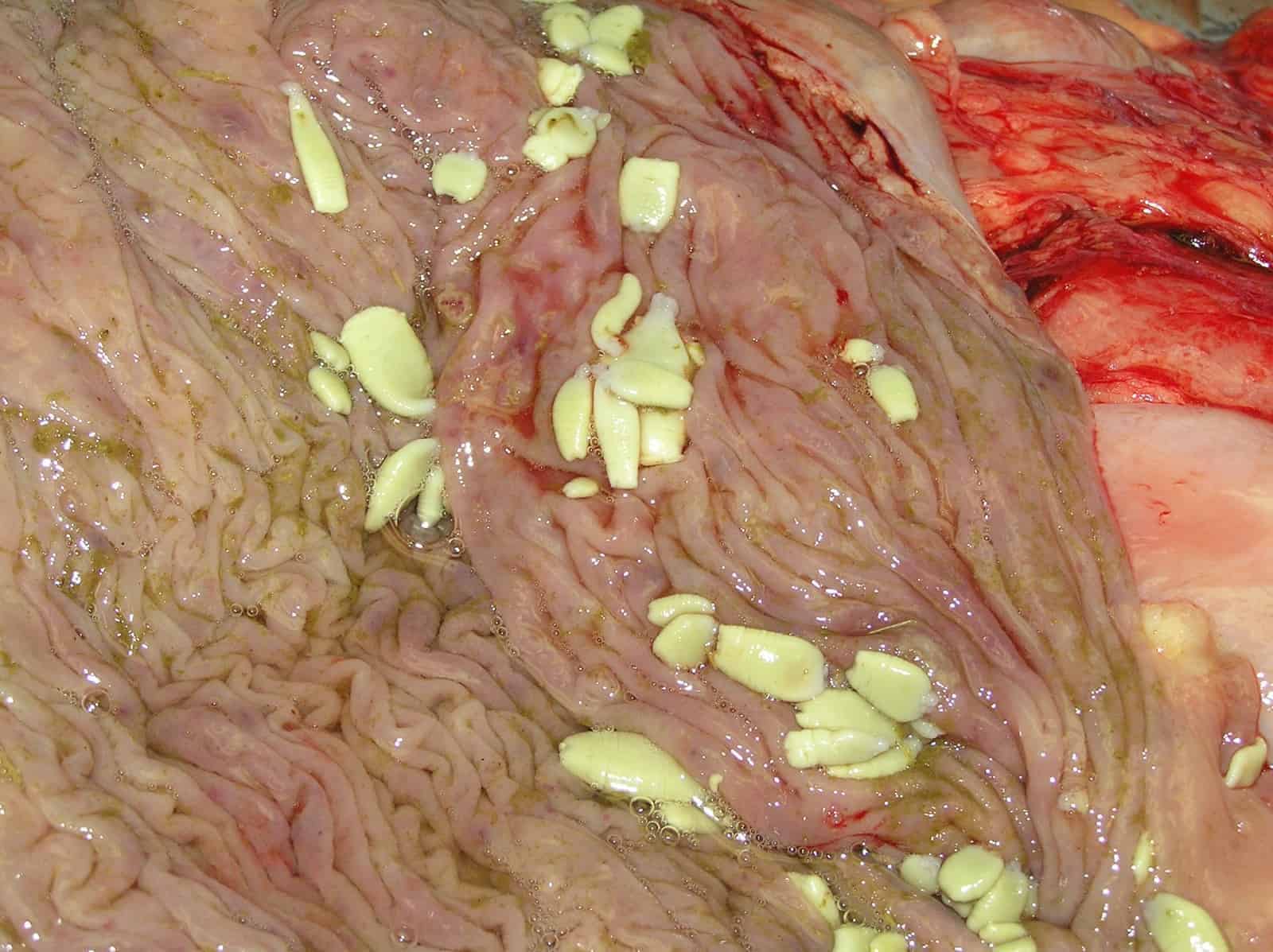
Tapeworms
Photo Credit: Dr. Martin Nielsen

Ascarids
Photo Credit: Dr. Martin Nielsen
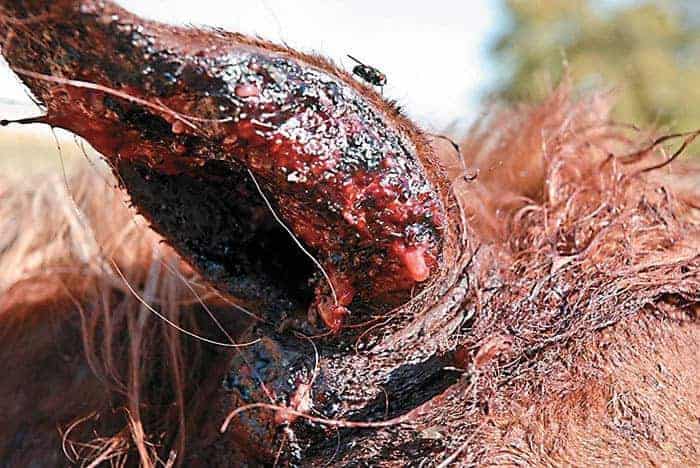
Summer Sores
Photo Credit: Dr. Martin Nielsen
Helminths (worms) and other intestinal parasites:
- Bloodworms (Strongylus vulgaris). Mostly eradicated in domestic horses, migrating bloodworm larvae can cause dangerous blood clots, artery damage, and colic.
- Cyathostomins, aka small strongyles. These are the most common helminth in equids today. Most horses don’t show clinical signs of infection, but if they develop acute larval cyathostominosis (a mass eruption of encysted larvae that causes an inflammatory response in the horse’s gastrointestinal tract) the fatality rate can reach 50%.
- Tapeworms (Anoplocephalaperfoliata). Heavy infections are associated with ileocecal colic.
- Ascarids, aka roundworms (Parascaris spp). These parasites are especially risky for young foals and can cause intestinal impaction.
- Pinworms (Oxyuris equi). Unassociated with serious disease, pinworms maintain their life cycle in the colon. Females lay eggs around the anus, causing itching.
- Bots (Gasterophilus spp). The larval stage of botflies, bots begin as yellow eggs on horses’ hair coats. The larvae hatch there due to warmth, moisture, and carbon dioxide, and the horses lick the larvae, which reside in oral tissues, then travel to the stomach. Not harmful as larvae, they might become a nuisance as adult flies.
- Skin-living larvae (Habronema and Draschia). These species can cause summer sores.
Resistance:
Generations of Survivors

PHOTO: The Horse
"Drug resistance is a natural biological consequence of incidentally selecting for a few individuals in these populations that happen to have the genes that allow them to survive."
- Dr. Martin Nielsen
“No method is 100% effective in killing all the parasites,” so there will always be survivors, says Hertzberg.
So, early parasites that survived a round of treatment probably had a natural level of resistance to it. Then, in a classic Darwinian case of survival of the fittest, they passed down that resistance through their genes to their offspring. Treatment wiped out the “unfit” worms, leaving those with the genes for resistance to reproduce, creating entire families of resistant helminths, Nielsen explains.
“Drug resistance is a natural biological consequence of incidentally selecting for a few individuals in these populations that happen to have the genes that allow them to survive,” he says.
Once parasites develop resistance, it remains, generation after generation. “It’s not like with antibiotics, where bacteria sometimes lose their resistance after several generations,” Nielsen says. “These worms are much more complex organisms, with genomes that are organized like other animals, DNA in the chromosomes, and much more genetic material. So once genes are acquired, they stay for the long haul.”
Anthelmintics (Deworming Drugs)
Anthelmintics are the drugs used to deworm horses. Here’s a guide to those drugs and how they work.
| Drug Class | Benzimidazoles | Pyrimidines | Macrocyclic Lactones | Isoquinoline-Pyrazines |
|---|---|---|---|---|
| Mode of Action | Attack worms’ cellular metabolism, depriving them of usable energy | Cause paralysis of the worms’ neuromuscular junctions | Target worms’ nerve and muscle cells, causing paralysis; highly potent at low doses; and also | Kill only tapeworms |
| Form | Paste, liquid, or pellets | Paste, liquid, or pellets | Paste or gel | Paste |
| Drug Names | Fenbendazole, oxibendazole, or oxfendazole | Pyrantel salts such as pyrantel pamoate and pyrantel tartrate | Ivermectin, moxidectin, or abamectin | Praziquantel |
Curbing Resistance
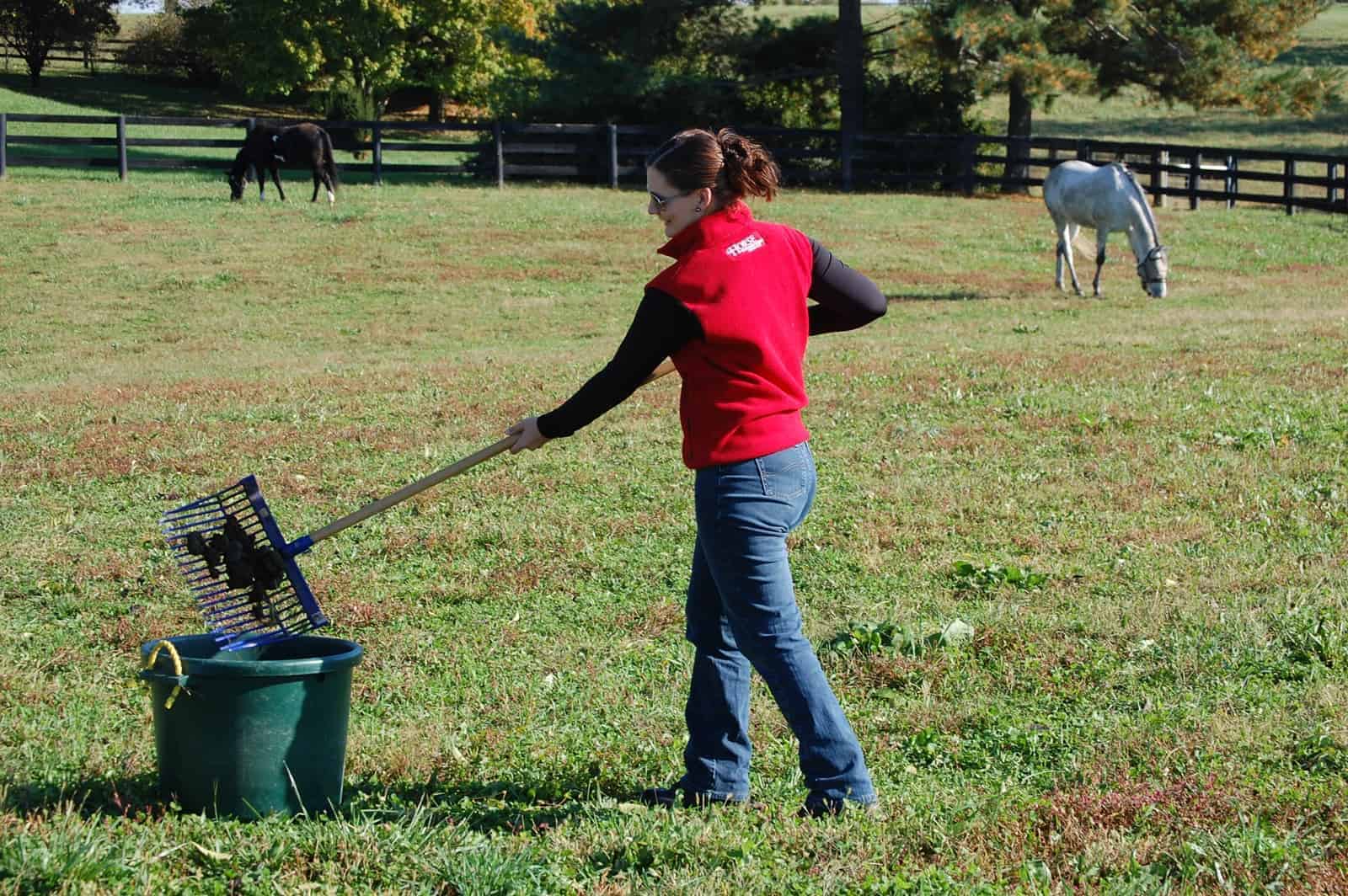
PHOTO: The Horse
An early critical step has been helping owners simply “let go” of the idea of the parasite-free horse, says Hertzberg. “We’re helping people accept the coexistence of host and parasite, which is the normal situation in all pastured animals,” he says.
Another important step is giving up that traditional rotational anthelmintic treatment program that veterinarians recommended in decades past, says Nielsen. It was useful when developed 50 years ago, aiming to kill bloodworms before they could mature and lay eggs—a cycle occurring approximately every two months. However, today bloodworms are rare in horses. And meanwhile, cyathostomins and roundworms are becoming increasingly more drug resistant.
While resistance can’t be undone, our sources say we can help prevent it from becoming more common. One important way of doing that appears to be through what Hertzberg refers to as a “check-before-treat system.” The method involves assessing individual horses and whole farms to determine, among other trends, which horses “contaminate” the environment the most by shedding the most parasite eggs.
It’s a method Hertzberg has been overseeing in farms across Switzerland for the past decade. The strategy involves veterinarians, stable owners, and horse owners making parasite control decisions based on “portfolios” of each farm’s parasite situation—the parasite load based on fecal egg counts, stable and pasture management approaches, farm type (sport, leisure, breeding), etc. With more than half of Swiss horse farms enrolled entirely or partly in the program, his scientific group has found that fecal egg counts are generally low and that most adult horses do very well with a single annual deworming treatment.
“I am not aware of a single horse running into clinical problems due to that strategy,” Hertzberg says.
While such a nationwide enrollment strategy doesn’t exist in the United States, owners and farm managers can still work with qualified veterinarians to determine individual treatment protocols based on a custom needs assessment. They should form all such protocols on basic egg counts from fecal samples, Nielsen says.
Keeping Bloodworms at Bay
Intensive deworming over the past few decades has led to near elimination of bloodworms (large strongyles), which can cause serious disease in horses (blood clots, artery damage, and colic). Still, we must continue to be vigilant about bloodworms, says Hubertus Hertzberg, PhD, a researcher at Switzerland’s University of Zurich Vetsuisse Faculty Institute of Parasitology and head of parasite monitoring at Health Balance, a private holistic animal management and veterinary practice, in nearby Niederuzwil.
Reducing deworming frequency—a practice currently recommended due to developing parasite resistance against common dewormers—could lead to their reemergence, he warns. If veterinarians and owners detect bloodworms on a farm, they should suspend the “check before treat” system until they’ve eliminated those worms.
“Before we started our portfolio management program (involving veterinarians, stable owners, and horse owners making parasite control decisions based on “portfolios” of each farm’s parasite situation), a study indicated a bloodworm prevalence of less than 2%, and we have no indication that this situation changed in the last decade,” he says.
Husbandry Practices to Manage Equine Internal Parasites
Managing internal parasites goes beyond just deworming. Incorporate the following management practices to protect your horse.
Clean paddocks of manure (Fig. 1)
Labor-intensive but effective, picking up manure daily or weekly prevents eggs from hatching on the pasture.
Compost manure (Fig. 2)
Naturally heating your gathered manure by composting it so it reaches high temperatures kills parasite eggs and larvae, which won’t survive 102°F (40°C).
Implement rotational grazing (Fig. 3)
Allow pastures to rest by using sacrifice areas and rotational grazing.
Graze multiple species on your pastures (Fig. 4)
Put cattle, sheep, goats, or even camelids (llamas, alpacas) on your horse pasture, instead of (or with) your horses. These species aren’t susceptible to equine strongyles, and they’ll eat through grass near where horses have defecated.
Use biological controls (Fig. 5)
A feed-through product containing nematophagous fungi, which eat worms, is harmless to people and the environment and has shown promising results.
Egg Counts:
The Foundation of Parasite Control
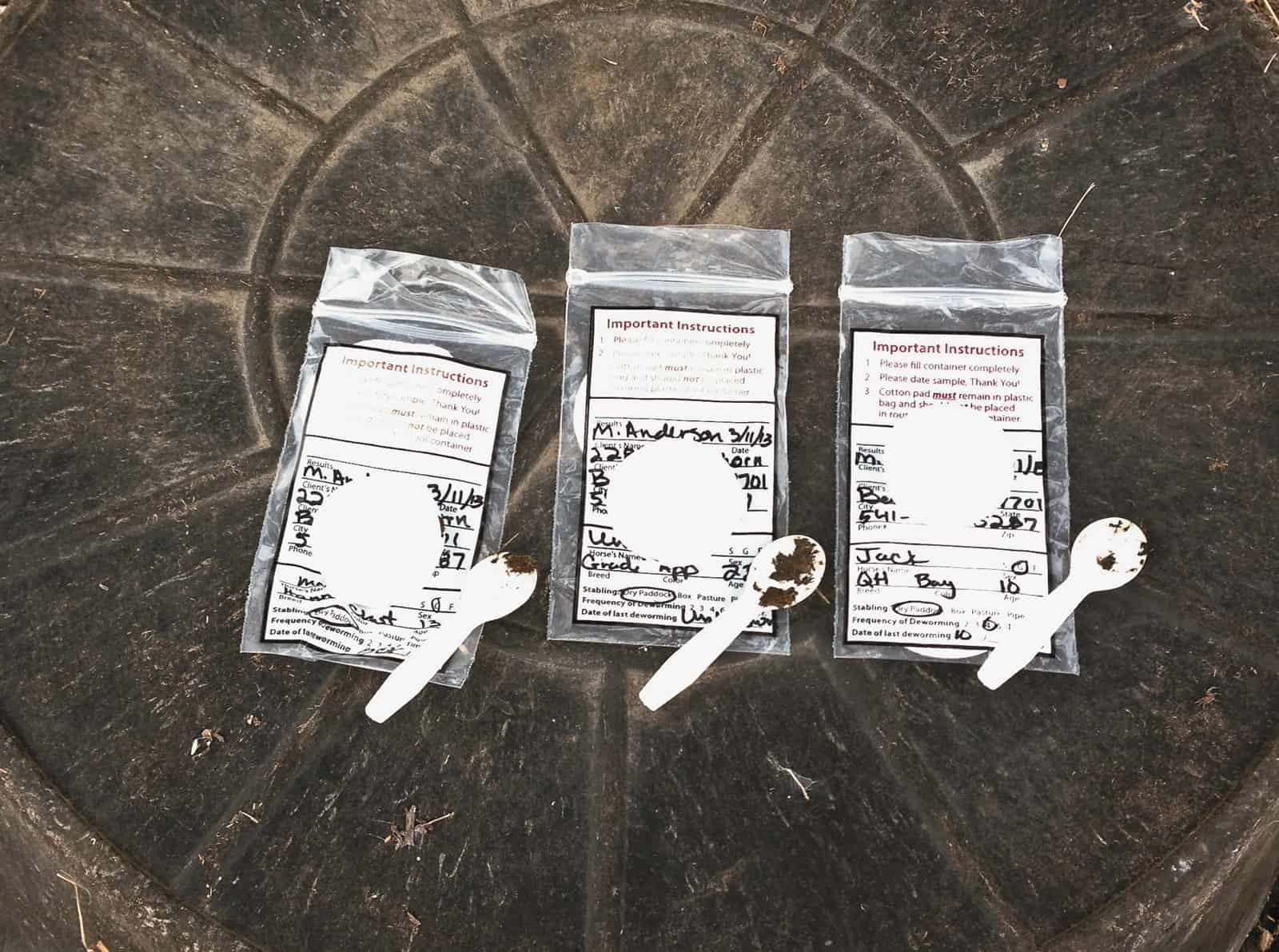
PHOTO: The Horse
Key to checking before treating are fecal analyses, which can reveal a lot about the kinds of parasites each horse is hosting, as well as how much he’s contributing to the herd’s general infection risk, says Nielsen. Fecal egg counts (FEC) show how many eggs individual horses shed—which can vary considerably from horse to horse. “Egg counts are the foundation for parasite control,” he says.

Adult horses with fewer than 200 strongyle eggs per gram (epg) of feces are considered “low shedders.” “High shedders” have loads of more than 500 epg, and “moderate shedders” fall between. However, horses in the latter categories don’t necessarily have proportional parasite burdens, Nielsen adds. “The fecal egg counts do not say anything about the intensity of infection,” he says. “They identify the high shedders, which is a different matter. ”
A horse that’s a high shedder contaminates the environment with parasite eggs more readily than other horses. These horses need treatment so they expose the herd to fewer eggs and larvae on pasture—not to improve their own individual health, says Nielsen. In other words, it’s a concept of community.
“It’s often only 15-20% of adult horses that shed about 80% of the eggs in the pasture,” says Nielsen, adding that horses usually remain consistent in their shedding rates throughout their lifetimes. In Hertzberg’s population, only 8% of samples show egg counts above 200 epg.

We can’t recognize these high-shedding horses by simply looking at them, our sources say. They’re not necessarily the weakest or thinnest, the least or most dominant, or the oldest or youngest. In fact, genetic predisposition for immunity might play a role, says Dr. Sara Ringmark. In her group’s study of 12 free-ranging Gotland Russ stallions, they noted better parasite resistance in three horses, two of which had the same sire. This seems to go along with an earlier finding by Canadian researchers studying feral horses on Sable Island, in Nova Scotia, that parasite resistance can be heritable, she says. Ringmark hopes to research the topic further.
Because horses can live healthy lives with controlled small strongyle burdens, our sources agree it’s better to just treat them less. While that might seem counterintuitive, science is revealing clear advantages: It keeps us from reducing the parasite load to only the parasites that resist anthelmintics. By allowing the light shedders to continue shedding, we’re letting the parasites maintain generations of worms that aren’t developing resistance because they haven’t been exposed to the drugs as much—a population known as refugia.
Egg counts also allow managers to look at the farm as a whole. They can identify trends, especially regarding types of parasites on the farm, and treatment efficacy. By checking FEC a few weeks after giving anthelmintics, for example, known as running a fecal egg count reduction test, they can determine the percentage of survivors, as well as how long it takes for eggs to start showing up in the feces again—both of which indicate levels of resistance.
In Hertzberg’s widely adopted system, his team uses a fecal egg count testing schedule that matches the calendar used for traditional rotational deworming—four times per year (cutting that to three times once farms show stability. Adult horses with strongyle epgs lower than 200 (with no other harmful parasite infection—roundworms, large strongyles—detected) receive no treatment. As a security measure, however, all horses receive a blanket anthelmintic treatment at the end of the grazing season (fall).
In a recent analysis of monitored stables, Hertzberg found that the average epg among nearly 17,000 samples from adult horses was only 60.

Sara Ringmark, PhD, is a researcher at the Swedish University of Agricultural Sciences Department of Anatomy, Physiology, and Biochemistry, in Uppsala
Simplified Yet High-Tech Egg Counting
The search for equine parasite eggs is nothing new. In fact, scientists were counting eggs in horse feces 100 years ago, says Martin Nielsen, DVM, PhD, Dipl. ACVM, of the University of Kentucky, in Lexington. “It’s time we came up with something more sophisticated,” he says, adding that advanced, more accessible technology could encourage more owners and veterinarians to check fecal counts before treating.
In recent years fecal egg counts have become easier and less expensive because owners can pick up poop themselves and send it into laboratories, Nielsen says.
Nielsen’s team, though, took it a step further. They developed an automated system with an app for fecal egg counting. “It analyzes a picture through a process that takes less than three minutes,” he explains. While it’s not as simple as snapping a photo of your horse’s poop and uploading it, it still allows veterinarians to prepare samples with stain according to set procedures in their offices and get analyses based on the system’s predefined image analysis.
“This is only the first generation of the product from a startup company,” he says. “With time I could see a consumer product developing, as well.”
Climate Considerations

PHOTO: iStock.com
It can be useful to consider how climate affects worm life cycles when managing parasites, says Nielsen. Parasites can reproduce year-round in warm, wet climates, meaning there’s a constant mix of worms at different stages in their life cycles. In cold climates with strong winters, more pronounced life patterns tend to appear.
“Colder climates tend to synchronize parasites’ stages of life, so they all start out young in spring and get old around the same time by the end of the year,” he says. This can affect deworming decision-making because “if they’re about to die of old age anyway, it doesn’t matter if we induce resistance (because survivors won’t reproduce).” By contrast, treating earlier in life increases selection pressure for resistance.
With climate change, the Swiss researchers are recognizing changes in parasite life cycle patterns, says Hertzberg. “Higher mean temperatures are accelerating larval development on pasture,” he says. “Longer pasture periods, starting earlier in spring and lasting as late as December, are increasing the number of parasite life cycles per year.”
“While researchers have a basic understanding of the connection between climate and parasite management, developing specific climate-based recommendations will require significant further research,” says Nielsen.
Basic Management Strategies
- Blanket treat all horses once a year in fall (also in spring, if indicated by your veterinarian) with anthelmintics targeting large strongyles, tapeworms, bots, and the skin-living larvae Habronema and Draschia.
- Put young horses up to age 3 on individualized deworming schedules according to their age and your veterinarian’s recommendations.
- Run fecal egg counts on each horse two to four times a year and request a specific test (coproculture, molecular diagnosis by PCR) at least once a year. Identify adult “high shedders” using fecal egg counts, and give them additional deworming treatments targeted to their specific parasites one or more times during the year, depending on climate and length of grazing season.
- Treat any horse whose sample shows the presence of roundworms, bloodworms, or tapeworms.
- Time these additional treatments with peak parasite transmission season (usually spring and fall) to ensure there are ample refugia (generations of worms that aren’t developing resistance because they haven’t been exposed to anthelmintics as much).
- Evaluate the efficacy of each of the farm’s dewormers every three years by testing fecal egg count before and 10-14 days after treatment (called a fecal egg count reduction test, or FECRT).
The Veterinarian:
Your Parasite Management Partner

PHOTO: iStock.com
Involving your veterinarian in your farm’s parasite management is “critical,” says Hertzberg. Veterinarians who’ve been trained in modern management of equine parasites understand the epidemiology, related pathologies (diseases), risk factors, clinical signs of disease, parasite life cycles, effects of climate and environment, and the fight against anthelmintic resistance. However, it’s equally important that the veterinarian has received appropriate training in farm management, Hertzberg adds.
“A lot of the vets coming just out of veterinary school will get that education, and others can sign up for classes (or continuing education) after graduation,” he says. “But many of the vets who’ve been in practice for years already will not have that specific training, so it’s necessary to ask if they have.”
What’s more, it’s vital that farms stick with a single portfolio manager—one veterinarian who assesses the farm’s parasite situation and makes recommendations. “You shouldn’t have parallel strategies going on, as they will be confusing for the owners,” Hertzberg says. “Just one strategy per farm, and you keep with that strategy over the long term as long as it works successfully.”
Protecting the Environment
Excessive deworming—that is, blanket treatment of all horses three or more times a year—doesn’t just encourage parasite resistance. It might also harm the ecosystem horses live in, says Ringmark.
“Horses can contribute to landscape preservation, but not if their anthelmintics are destroying the local fauna and flora,” she says. Macrocyclic lactones, for example, are toxic for arthropods, fish, and soil nematodes, among others. Her group tried controlling equine parasites using a different drug—pyrantel, which “has a small ecotoxic (harmful to animals, plants, or the environment) impact.”
Unfortunately, it wasn’t effective enough alone to keep their 12 young stallions within acceptable egg-per-gram rates. “We occasionally had to use macrocyclic lactones,” she says.
The Veterinarian:
Your Parasite Management Partner
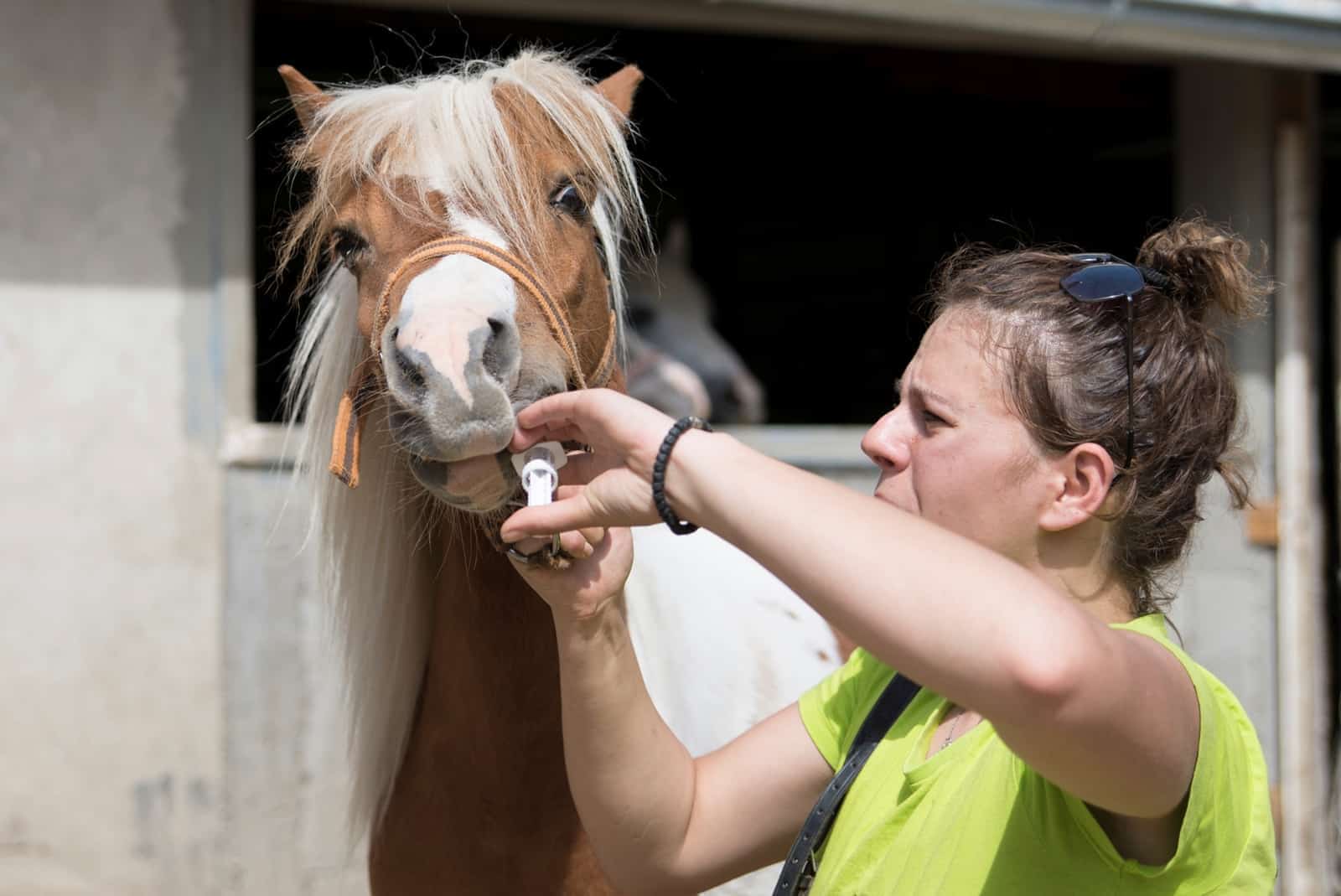
PHOTO: The Horse
Equine parasite management has entered a new era with new strategies for efficacy. It might take time for all owners and veterinary practices to switch over to individualized portfolio-based treatment protocols. But global efforts for improvement can help prevent the serious and irreversible situation of parasite resistance, in which parasites no longer respond to treatment and our existing dewormers no longer work. By following science-based recommendations, owners and their veterinarians can ensure they can manage parasites effectively for the long term.
About the author:
 Christa Lesté-Lasserre, MA
Christa Lesté-Lasserre, MA
Passionate about horses and science from the time she was riding her first Shetland Pony in Texas, Christa Lesté-Lasserre writes about scientific research that contributes to a better understanding of all equids. After undergrad studies in science, journalism, and literature, she received a master’s degree in creative writing. Now based in France, she aims to present the most fascinating aspect of equine science: the story it creates. Follow Lesté-Lasserre on Twitter @christalestelas.
Editorial Director: Stephanie L. Church
Managing Editor: Alexandra Beckstett
Digital Editor: Haylie Kerstetter
Art Director: Claudia Summers
Web Producer: Jennifer Whittle
Publisher: Marla Bickel
